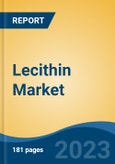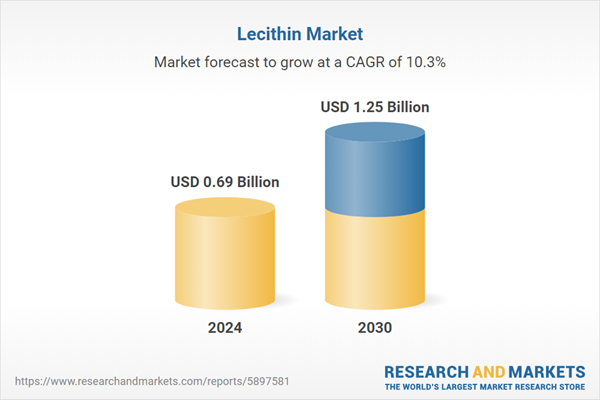Speak directly to the analyst to clarify any post sales queries you may have.
10% Free customizationThis report comes with 10% free customization, enabling you to add data that meets your specific business needs.
However, the market faces several challenges, particularly regarding the variability in raw material availability and fluctuating prices of soybeans and sunflower seeds. Regulatory concerns also play a crucial role, as differences in lecithin labeling, purity standards, and genetically modified organism (GMO) content across regions can complicate global supply chains. Moreover, competition from synthetic emulsifiers and lecithin alternatives with tailored functionalities adds pressure on manufacturers to invest in innovation and product differentiation.
Key Market Drivers
Diverse Applications
Lecithin, a multifunctional compound derived from sources such as soybeans, sunflower seeds, and eggs, is witnessing rising demand due to its wide-ranging applications. In the food industry, lecithin is valued for its emulsifying and stabilizing capabilities, enhancing texture, appearance, and shelf life. Over 80% of commercially available lecithin is used in food processing, including baked goods, chocolates, dairy, and margarine. Additionally, approximately 60% of global chocolate manufacturers rely on lecithin to maintain consistency and flow properties in their products.In pharmaceuticals, lecithin plays a vital role in drug formulation by improving the solubility and bioavailability of active ingredients. Its application in lipid-based drug delivery systems enables more effective treatment outcomes. With an increasing focus on advanced drug delivery technologies, pharmaceutical companies are turning to lecithin to improve patient compliance and therapeutic efficiency. Moreover, lecithin is now being utilized in around 30% of new nutraceutical formulations due to its ability to aid in nutrient absorption and liver support, reinforcing its role in the growing health and wellness sector.
Beyond food and pharma, lecithin’s demand is climbing in cosmetics, industrial, and beverage applications. In personal care, lecithin enhances the stability and delivery of active ingredients, with over 40% of natural skincare brands incorporating it for its moisturizing and skin-soothing properties. In beverages, especially protein drinks and dairy alternatives, lecithin ensures ingredient uniformity and improves texture. The industrial sector also uses lecithin in paints, coatings, and inks for dispersion and adhesion benefits, showcasing its versatility across traditional and emerging industries.
The expanding preference for natural, clean-label, and plant-based ingredients has further propelled lecithin’s adoption across industries. As consumers scrutinize product labels and seek alternatives to synthetic additives, lecithin’s natural origin and multifunctionality give it a competitive edge. Notably, sunflower lecithin - often non-GMO and allergen-free - is gaining traction as a substitute for soy-derived variants, especially in North America and Europe. This shift aligns with the fact that over 35% of global food product launches now carry clean-label claims, underscoring the growing importance of natural emulsifiers like lecithin.
Key Market Challenges
Fluctuations in Raw Material Prices
Fluctuations in raw material prices pose a significant challenge to the global lecithin market, impacting both production costs and supply chain stability. Lecithin is primarily sourced from soybeans, sunflowers, and rapeseed commodities that are highly sensitive to climatic conditions, geopolitical tensions, and market demand. For instance, adverse weather patterns in major producing regions like Brazil and Argentina can drastically reduce soybean yields, leading to sudden price surges. Such volatility directly affects lecithin manufacturers, who often operate on tight margins.Moreover, the increasing global demand for non-GMO and organic variants of lecithin, especially sunflower-derived lecithin, has intensified price fluctuations. The limited availability of these premium raw materials results in inconsistent supply and elevated procurement costs. In addition, trade restrictions, export duties, and logistic disruptions - such as those experienced during the COVID-19 pandemic have further amplified the unpredictability in sourcing key inputs. This makes it challenging for manufacturers to maintain steady production and pricing.
These price instabilities also hinder long-term planning and investment decisions across the value chain. Smaller players, in particular, struggle to absorb cost hikes without passing them on to consumers, which can affect their competitiveness. Furthermore, lecithin buyers in food and pharmaceutical sectors demand consistent quality and pricing, putting additional pressure on suppliers to stabilize costs. Unless raw material sourcing becomes more resilient and diversified, the lecithin market may continue facing challenges that impact both profitability and supply reliability.
Key Market Trends
Health and Wellness Trends
The global health and wellness movement has catalyzed significant shifts in consumer preferences, fostering a growing demand for clean-label, natural, and functional ingredients. One beneficiary of this paradigm shift is lecithin, a natural fatty substance derived from sources like soybeans and sunflowers. Lecithin is increasingly being recognized for its versatile applications and potential health benefits. One of the key pillars of health and wellness trends is a preference for natural and clean-label ingredients. Consumers are increasingly scrutinizing product labels, seeking to avoid artificial additives, preservatives, and chemicals. Lecithin, as a naturally occurring substance, aligns perfectly with this trend.Manufacturers are turning to lecithin as an alternative to synthetic emulsifiers and stabilizers, as it offers clean-label appeal and is recognized as a safe and familiar ingredient. Lecithin is associated with several potential health benefits, making it a valuable addition to health-conscious consumers' diets. Some of these benefits include improved cholesterol management, liver function support, and enhanced cognitive function. As consumers become more aware of these advantages, they are more likely to seek out products that contain lecithin, further fueling demand in the market. The dietary supplement industry has been a major beneficiary of the health and wellness trend.
Lecithin supplements have gained popularity due to their potential health benefits. They are often marketed as natural remedies for improving heart health and cognitive function. As consumers increasingly turn to supplements to fill nutritional gaps and support their well-being, the demand for lecithin-based supplements is expected to rise. In the food and beverage industry, lecithin plays a crucial role as an emulsifier and stabilizer. It enhances the texture and shelf life of various products, from baked goods to dairy items and processed foods. Health-conscious consumers are not only looking for products with clean labels but also those that offer nutritional benefits.
Lecithin can provide both, making it an attractive ingredient for manufacturers aiming to cater to health-conscious consumers. Lecithin's emulsifying and moisturizing properties have found applications in the cosmetic and personal care industry. As consumers prioritize skincare and personal well-being, products with natural and skin-friendly ingredients, like lecithin, gain traction. This trend has led to an increased use of lecithin in skincare, haircare, and other personal care products.
Key Market Players
- Cargill Inc
- Archer-Daniels-Midland Co
- Lipoid GmbH
- Bunge Limited
- American Lecithin Company
- Global River Food Ingredients
- DuPont de Nemours Inc
- Stern-Wywiol Gruppe GmbH & Co KG
- Haneil Soyatech Pvt. Ltd.
- NOW Foods
Report Scope:
In this report, the Global Lecithin Market has been segmented into the following categories, in addition to the industry trends which have also been detailed below:Lecithin Market, By Source:
- Soy
- Sunflower
- Rapeseed
- Others
Lecithin Market, By End-use:
- Convenience Food
- Bakery
- Confectionary
- Pharmaceutical
- Personal Care and Cosmetics
- Animal Feed
- Others
Lecithin Market, By Form:
- Liquid
- Powder
- Granules
Lecithin Market, By Region:
- North America
- United States
- Canada
- Mexico
- Europe
- Germany
- United Kingdom
- France
- Italy
- Spain
- Asia-Pacific
- China
- Japan
- India
- Australia
- South Korea
- South America
- Brazil
- Argentina
- Colombia
- Middle East & Africa
- South Africa
- Saudi Arabia
- UAE
- Kuwait
Competitive Landscape
Company Profiles: Detailed analysis of the major companies present in the Global Lecithin Market.Available Customizations:
With the given market data, the publisher offers customizations according to a company's specific needs. The following customization options are available for the report.Company Information
- Detailed analysis and profiling of additional market players (up to five).
This product will be delivered within 1-3 business days.
Table of Contents
Companies Mentioned
- Cargill Inc
- Archer-Daniels-Midland Co
- Lipoid GmbH
- Bunge Limited
- American Lecithin Company
- Global River Food Ingredients
- DuPont de Nemours Inc
- Stern-Wywiol Gruppe GmbH & Co KG
- Haneil Soyatech Pvt. Ltd.
- NOW Foods
Table Information
| Report Attribute | Details |
|---|---|
| No. of Pages | 180 |
| Published | August 2025 |
| Forecast Period | 2024 - 2030 |
| Estimated Market Value ( USD | $ 0.69 Billion |
| Forecasted Market Value ( USD | $ 1.25 Billion |
| Compound Annual Growth Rate | 10.3% |
| Regions Covered | Global |
| No. of Companies Mentioned | 10 |









